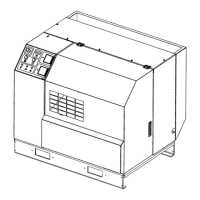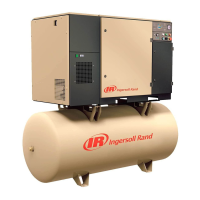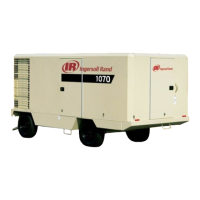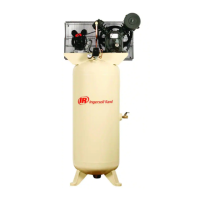
Do you have a question about the Ingersoll-Rand XP900WCU and is the answer not in the manual?
| Brand | Ingersoll-Rand |
|---|---|
| Model | XP900WCU |
| Category | Air Compressor |
| Language | English |
Outlines critical safety measures and general information for operation and maintenance.
Details warranty coverage for various compressor and engine components.
Instructions for properly positioning and preparing the unit before operation.
Discusses the importance of maintenance for unit performance and longevity.
Provides daily, weekly, monthly, and interval maintenance schedules for small units.
Explains the importance of lubrication and lists items requiring regular service.
Outlines a systematic approach to troubleshooting problems, starting with basic checks.
Lists common unit shutdown symptoms, their causes, and corrective actions.
Identifies intake air restriction as a cause for slow pressure rise and suggests checking air cleaner.
Links intake air restriction to excessive oil pumping and suggests checking air cleaner.
Identifies air system leaks as a cause for the compressor not stopping pumping.
Identifies coolant leaks as a cause for coolant loss and suggests visual inspection.
Identifies low coolant level as a cause for sudden overheat and suggests adding coolant.
Identifies low fuel level as a cause for the engine not starting and suggests adding fuel.
Checks battery voltage, suggesting recharge if below 7 volts, as a cause for starting issues.
Links insufficient oil supply or low pressure to excessive engine noise.
Identifies restricted fuel drain lines or plugged vents as causes for low engine power.
Refers to symptom chart for engine not starting issues.
Identifies low fuel level as a cause for speed surges.
Suggests adding fuel if the engine starts but does not keep running.
Identifies insufficient air pressure in the tank as a cause for the engine not cranking.
Suggests reducing load or using lower gear if engine power is insufficient.
Identifies an open fuel pump manual override as a cause for the engine not shutting off.
Identifies incorrect oil level as a cause for low oil pressure.
Identifies incorrect oil level as a cause for high lubricating oil temperature.
Identifies restricted intake air system as a cause for black smoke.
Suggests checking turbocharger part number and replacing if necessary for low boost.
Explains how to use troubleshooting charts to diagnose specific engine symptoms.












